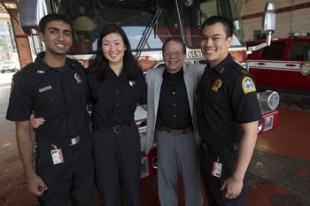Rice Emergency Medical Services volunteers meet the man they saved
Robert Botto was dead and would have remained so if students with Rice Emergency Medical Services (REMS) weren’t in place nearby.
Botto, 63, a biofuels chemist with KiOR Inc., was warming up for a 3,000-meter race at Rice last June when he stopped, walked to the side of the track and collapsed. Quick and correct procedures by REMS responders and Rice undergraduates Amol Utrankar, Linda Wang and Christopher Leba restored his pulse by the time a Houston Fire Department (HFD) crew arrived a few minutes later.

Members of the Rice Emergency Medical Services team met at Houston Fire Department Station 33 on March 22 with a patient whose life they helped save. From left, Amol Utrankar, Linda Wang, Robert Botto and Christopher Leba. Photo by Jeff Fitlow
At a reunion ceremony at Station 33 on March 22, HFD honored all those who saved Botto’s life: the fellow runners who immediately started CPR and called 911, the dispatcher who answered, the Rice students who revived his pulse with a defibrillator and the HFD responders who took over advanced medical care and brought him to the Methodist Hospital.
Botto and his wife, Kathy, had the opportunity to tell their story and thank the entire team.
“I was dead for 50 minutes,” Botto said. “I just laid down and that was it. Eight days of my life disappeared. I woke up in the hospital on the 17th of June.”
Doctors eventually diagnosed a genetic condition that caused his cardiac arrest. “It was probably the inability of my body to absorb folic acid,” Botto said. “I was not aware of it before at all. People don’t normally live past their 30s with that problem.”
Botto isn’t just any runner. His track record includes a number of 100-mile races and many shorter runs that exceed marathon length. A fellow of the American Chemical Society who returned to work last October, he has since had a 32-mile run and will run 40 miles in the American Cancer Society’s Relay for Life in Baytown next month.
But he never made it to the start last June 9, when the Exxon Corporate Relays took place at Rice’s Holloway Field. Utrankar and Wang were assigned to work the event for REMS and noticed the commotion as Botto’s runner friends started CPR. “We ran over to make an assessment and set things in motion to prolong his life until HFD could get there,” Utranker said. “We managed to get a pulse back, and by the time HFD arrived, they were able to get him to Methodist really quickly.”
Leba, REMS’ student captain, was on call and arrived a few minutes after Utranker and Wang, working her first EMS case, applied the defibrillator. “I started helping with advanced life support stuff,” said Leba. “We established an IV line for medications and worked on establishing an advanced airway, where you put a tube down the throat. After that, HFD arrived on the scene.”
‘I was dead for 50 minutes. I just laid down and that was it. Eight days of my life disappeared.’ — Robert Botto
“This is one of those circumstances where, because we had a crew at the track stadium, they were able to get there three minutes sooner than if they were just responding to a call,” said Mark Escott, REMS medical director, who attended the ceremony with REMS Director Lisa Basgall. “That three minutes represents a 30 percent increase in the chance of survival from sudden cardiac arrest. I think in this circumstance, it made the difference.”
David Persse, Houston Fire Department EMS physician director and a public health authority for the city, said having the entire chain of responders in place is critical to saving lives. “We as a community and a society put certain safeguards in place to help treat people like this, because it’s a potentially fatal event, but not necessarily a fatal event,” he said. “Whether it’s going to be fatal or not really depends not on the patient, but on the community that surrounds that patient and what they do and how they respond.”
Persse presented certificates of appreciation to each of the responders, who represented what he said were the four links in the “chain of survival” for cardiac arrest: early bystander CPR, early 911 access, early defibrillation and early advanced life support.
“In your case,” Persse told Botto, “those links were in place.”
“And they all worked, too,” Botto said.
Persse said reunions of emergency responders and their patients are rare but valuable. “We don’t get the rest of the story,” he said. “When we hand somebody off to the hospital as critically ill as you were, you can’t help but walk away with your head down and a little bit of a shuffling gait thinking, ‘Gee, I hope he does well, but he probably won’t.’ That sticks with you.”
Escott, who founded REMS as a Rice undergraduate, appreciates the payoff for years of lifesaving dedication. “We’re privileged the university has supported this program for the past 17 years, and it’s because of that commitment to emergency medical services that this man is alive today,” he said.
Robert and Kathy Botto appreciate it most of all. Upon their arrival, Botto greeted the Rice students warmly. “It’s great to see you folks,” he said. “Do you remember me?”
Seriously, how could they ever forget?


Leave a Reply